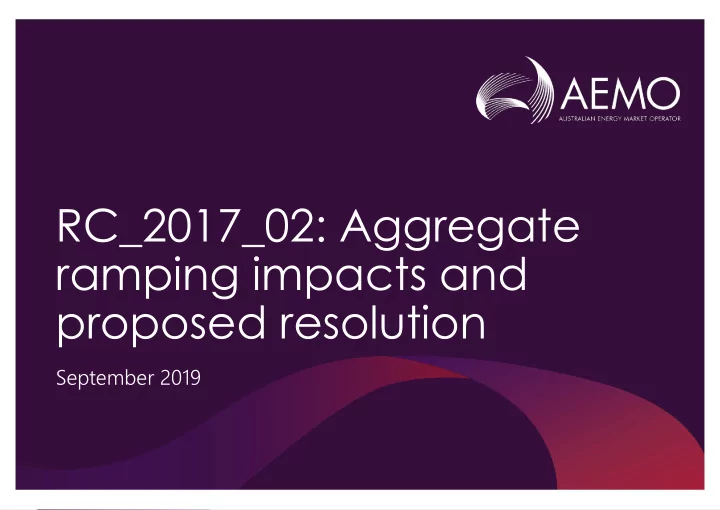

RC_2017_02: Aggregate ramping impacts and proposed resolution September 2019
Aggregate ramping issues with gate- closure • The WEM Rules ensure that generation equals the demand forecast at the last second of the Trading Interval • Balance means the SWIS frequency is maintained • However, during the Trading Interval there is always imbalance • All movements of Facilities during the Trading Interval can affect that balance, whether that movement is scheduled or unscheduled • The Load Following (LFAS) requirement is set to cover unscheduled movements in load or generation to maintain the balance • Ramping is a scheduled movement • Any scheduled movement will impact the balance if not offset • And therefore, LFAS Facilities will automatically react to cover the imbalance and maintain the SWIS frequency – this is unavoidable • When LFAS Facilities respond to scheduled movements, the ability to respond to unscheduled movements decreases • As effective LFAS is less than the requirement • This has consequential impacts on Spinning Reserve and Load Rejection Reserve • The variability and frequency of unscheduled movements is increasing due to increasing quantity of Non-Scheduled Generation and residential solar PV
Aggregate ramping issues with gate-closure(2) • To avoid impacting LFAS, Balancing Portfolio Facilities providing LFAS should not be used to respond to scheduled movements • The Balancing Portfolio ramp rate is limited once Facilities providing LFAS are excluded • Easy for the Balancing Portfolio ramp rate to be exceeded when the aggregate Non-Synergy ramp rate is high or several Facilities ramp at once • Currently, AEMO responds to Non-Synergy scheduled movements by: • Dispatching the Balancing Portfolio to offset the movement as it occurs, where the Balancing Portfolio ramp rate is sufficient • Dispatching the Balancing Portfolio in advance to limit the impact on LFAS • For situations where the difference in ramp rate is not excessive • Otherwise, issuing Dispatch Instructions to Non-Synergy Facilities • A 60 minute gate-closure will preclude the option of dispatching the Balancing Portfolio in advance
Example impacts • AEMO has reviewed the Balancing Portfolio ramp rate • The actual capability is dynamic depending on Facilities currently online or forecast to be online • The chart indicates the impacts of two non- Synergy Facilities ramping by 100 MW at different rates • Here the demand growth is zero • The change in BMO quantity for the Balancing Portfolio is zero
Synergy Trading Interval ramp up rates excluding LFAS Facilities over time
Synergy Trading Interval ramp down rates excluding LFAS Facilities over time
Comparison of Jan and Feb 2019 – difference due to LFAS clearance
Conclusions on Balancing Portfolio ramp rate • The Trading Interval Balancing Portfolio ramp rate has varied over time • Suspected causes of variation over time include: • Total Balancing Portfolio BMO quantity – which impacts the number of Balancing Portfolio Facilities • Balancing Portfolio LFAS clearance – which impacts the number of Balancing Portfolio Facilities excluded from the determination of the ramp rate • Current Balancing Portfolio ramp down rate • <= 20 MW/min for 38% of Trading Intervals and • <= 10 MW/min for 3% of Trading Intervals • Current Balancing Portfolio ramp up rate • <= 20 MW/min for 24% of Trading Intervals and • <= 10 MW/min for 2% of Trading Intervals • AEMO is investigating methods to forecast when the Balancing Portfolio ramp rate might be exceeded • The aggregate ramping impact is occurring now • A 60 minute gate- closure will limit AEMO’s options to respond • By precluding the option of dispatching the Balancing Portfolio in advance
Proposed resolution – issue Dispatch Instructions at a linear ramp rate • Non- Synergy Facilities must ramp according to the ramp rate in AEMO’s Dispatch Instruction • Currently all Dispatch Instructions default to the Ramp Rate Limit • The ramp rate indicated by the Participant in the Balancing submission • AEMO currently varies the Dispatch Instruction ramp rate as a last resort • A linear ramp rate would require the Facility to ramp evenly throughout the interval (linear ramping) • The ramp rate may be less than the Ramp Rate Limit • Determined by: change in BMO quantity / minutes remaining in Trading Interval • The Facility’s energy output during the ramping Trading Interval would vary • Linear ramping would mitigate any imbalance during the Trading Interval caused by scheduled movements • Expectation is that WEM Reform will require linear ramping at all times
Proposed resolution – issue Dispatch Instructions at a linear ramp rate (2) • AEMO has reviewed the WEM Rules and concludes that: • AEMO can issue a Dispatch Instruction with a ramp rate not equal to the Ramp Rate Limit in a Normal Operating State • This dispatch is not Out of Merit • The Facility will receive constrained-off payments for the difference in ramp rates • AEMO considers this the only valid approach to mitigate aggregate ramping impacts • To facilitate a 60 minute gate closure, AEMO will need to introduce linear ramping whenever the aggregate ramping exceeds the forecast of the Balancing Portfolio’s ramp rate • This would be an automated process based on a forecast of the ramp rate • AEMO is considering introducing linear ramp rates in current operations where whenever the aggregate ramping exceeds the forecast of the Balancing Portfolio’s ramp rate • However, a longer gate-closure that allows dispatch of the Balancing Portfolio in advance may reduce the frequency of dispatch using linear ramp rates
Recommend
More recommend